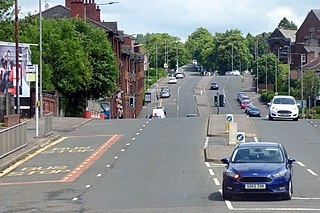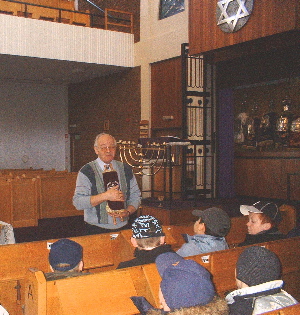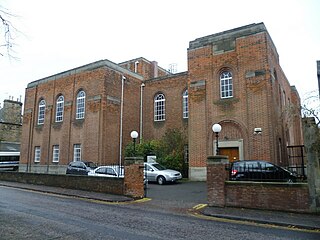The Gorbals is an area in the city of Glasgow, Scotland, and former burgh, on the south bank of the River Clyde. By the late 19th century, it had become densely populated; rural migrants and immigrants were attracted by the new industries and employment opportunities of Glasgow. At its peak, during the 1930s, the wider Gorbals district had swollen in population to an estimated 90,000 residents, giving the area a very high population density of around 100,000 per sq. mi. (40,000/km2). Redevelopment after WWII has taken many turns, and the area's population is substantially smaller today. The Gorbals was also home to 16 high rise flat blocks; only six are standing as of 2024, and two of them are set to come down at some point this year.

Riddrie is a north-eastern district of Glasgow, Scotland. It lies on the A80 Cumbernauld Road.

The West London Synagogue, abbreviated WLS, and fully the West London Synagogue of British Jews is a Reform Jewish congregation and synagogue, located near Marble Arch, at 34 Upper Berkeley Street, in the City of Westminster, in Central London, England, in the United Kingdom.

The history of the Jews in Scotland goes back to at least the 17th century. It is not known when Jews first arrived in Scotland, with the earliest concrete historical references to a Jewish presence in Scotland being from the late 17th century. Most Scottish Jews today are of Ashkenazi background who mainly settled in Edinburgh, then in Glasgow in the mid-19th century. In 2013 the Edinburgh Jewish Studies Network curated an online exhibition based on archival holdings and maps in the National Library of Scotland exploring the influence of the community on the city.

Moorish Revival or Neo-Moorish is one of the exotic revival architectural styles that were adopted by architects of Europe and the Americas in the wake of Romanticist Orientalism. It reached the height of its popularity after the mid-19th century, part of a widening vocabulary of articulated decorative ornament drawn from historical sources beyond familiar classical and Gothic modes. Neo-Moorish architecture drew on elements from classic Moorish architecture and, as a result, from the wider Islamic architecture.

The Singers Hill Synagogue, officially the Birmingham Hebrew Congregation, is an Orthodox Jewish congregation and synagogue, located at 26, 26A and 26B Blucher Street, in the Birmingham city centre, in the West Midlands of England, in the United Kingdom. The congregation dates from 1780 and worshiped in the Ashkenazi rite.

Bridge Street railway station, now disused, was the original Glasgow terminus of the Glasgow and Paisley Joint Railway; jointly owned by the Glasgow, Paisley and Greenock Railway (GP&G), which later merged with the Caledonian Railway, and the Glasgow, Paisley, Kilmarnock and Ayr Railway (GPK&A), which became part of the Glasgow & South Western Railway.

Myer Galpern, Baron Galpern, DL was a Scottish Labour Party politician.

The Giffnock Newton Mearns Synagogue, commonly known as Giffnock Shul, is an Orthodox Jewish congregation and synagogue, located at 222 Fenwick Road in Giffnock, East Renfrewshire, on the south side of Glasgow, Scotland, in the United Kingdom. The synagogue is the largest in Scotland and also features a religious day school for both children and teenagers.

TheGreat Synagogue is an Orthodox Jewish congregation located in a large heritage-listed synagogue at 187a Elizabeth Street in the Sydney central business district in the City of Sydney in New South Wales, Australia.

The Glasgow trolleybus system operated in and immediately surrounding the city of Glasgow, Scotland, between 1949 and 1967, with the network reaching its largest extent in 1959. It was the only British system to open after World War II.
Charles Frank (1865–1959) was an optical and scientific instrument maker from Glasgow, Scotland.

The Garnethill Synagogue is an Orthodox Jewish congregation and synagogues located in Garnethill, Glasgow, Scotland, in the United Kingdom. Completed in 1881, the historic synagogue is considered the 'cathedral synagogue' of Scotland.

Sandy's Row Synagogue is an Orthodox Jewish congregation and synagogue, located on Sandys Row, on the corner of Middlesex Street in Bishopsgate, in the East End, Borough of Tower Hamlets, London, England, in the United Kingdom.
Glasgow Reform Synagogue is a Reform Jewish synagogue, located in Newton Mearns, East Renfrewshire, Scotland, in the United Kingdom. The congregation is a member of the Movement for Reform Judaism and is the only Reform synagogue in Scotland. The synagogue was first known as Glasgow Progressive Synagogue, then Glasgow New Synagogue, before taking its current name.

The Edinburgh Synagogue is an Orthodox Jewish congregation and synagogue, located at 4 Salisbury Road in the Newington area of Edinburgh, Scotland, in the United Kingdom. Established in 1816 as the Edinburgh Hebrew Congregation, the congregation worships in the Ashkenazi rite.

The Central Synagogue is an Orthodox Jewish congregation and synagogue, located at 133-141 Great Portland Street, with additional frontage to Hallam Street, in the City of Westminster, London, England, in the United Kingdom. The congregation worships in the Ashkenazi rite and is a founding member of United Synagogue.

The Langside Synagogue is a former Orthodox Jewish synagogue, located near Govanhill in Glasgow, Scotland. It opened in May 1927 and closed in 2014. Whilst active, the congregation worshiped in the Ashkenazi rite.
The Scottish Jewish Archives Centre (SJAC) is the largest repository of items relating to Jewish migration to Scotland and life in Scotland. It aims to document and illustrate the religious, organisational, social, economic, political, cultural and family life of Jews in Scotland from the 18th century to the present-day in order to heighten awareness - and to stimulate study of - the country's Jewish heritage.















